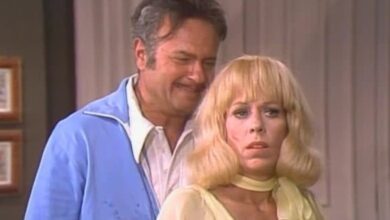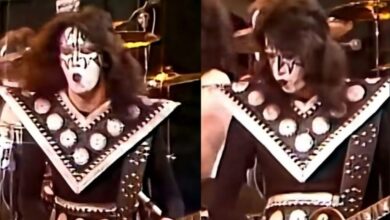Chris Stapleton Brings Raw, Soul-Shaking Power to the CMA Awards 2025 with “Bad As I Used To Be”
Chris Stapleton’s appearance at the 59th CMA Awards on November 19, 2025, came at a point in the show where the room was already buzzing, but still waiting for that one performance that would reset the night’s heartbeat. Bridgestone Arena had been through big sing-alongs and shiny production numbers, yet when Stapleton walked out with a guitar and that calm, unhurried stride, the atmosphere tightened in a good way. It felt like everyone knew the temperature was about to change, even before the first chord landed.
The CMAs built his slot as a clean, uncluttered moment, and that was the smartest possible framing. No dancers, no fireworks, no storyline skits — just a stage that looked like it belonged to a live band, not a TV spectacle. The lights stayed warm and focused, giving the performance a gritty, late-night-club feel inside a giant arena. That visual restraint quietly said, “watch the musicians,” and Stapleton’s whole career has been a promise that if you do, you’ll get something real.
“Bad As I Used To Be” is a newer Stapleton cut, released earlier in 2025 as part of F1: The Album, the soundtrack tied to the Formula 1 film project. That origin matters because the song already carries a sense of speed and friction — a blues-rock pulse that feels like engines humming under the vocal. Yet despite coming from a movie world, the track is pure Stapleton in spirit: confession disguised as swagger, a man admitting the fight between who he wants to be and who he still is.
On the CMA stage, the opening guitar figure arrived like a slow roll of thunder. The band eased in behind him, not rushing the groove, letting the riff breathe before it started to bite. You could hear how the live arrangement leaned harder into the blues side of the song, with the rhythm section pushing a thicker, dirtier pocket than the studio version. It wasn’t a reinvention, more like the song taking its boots off and stepping into its natural habitat.
Stapleton’s vocal came in with that growl that somehow stays melodic even when it’s tearing at the edges. He didn’t perform like someone trying to win a TV moment; he performed like someone telling the truth and trusting the silence between lines. His phrasing was loose, slightly behind the beat, which gave the lyric extra weight. That’s one of his quiet superpowers — he can make a stadium feel like a small room just by slowing his delivery a hair.
The lyric itself hits like a shrug with a bruise under it. “Bad As I Used To Be” isn’t a victory song about changing your life; it’s an honest admission that some habits stick, some impulses don’t vanish, and sometimes you have to own the mess while you’re still working through it. Nashville audiences respond to that kind of blunt self-awareness, and you could feel the crowd leaning in as the chorus arrived, because it wasn’t just catchy — it was recognizable.
Midway through, the performance opened up into the guitar work that made people sit up. Stapleton doesn’t treat solos like a “now I’ll impress you” moment; he treats them like another verse in the story. The first solo came in quick and sharp, full of sting, then he let the band swell behind it. A second, more ripping break later in the song raised the heat even more, the kind of run that sounds effortless until you remember how hard it is to play that cleanly live.
The cameras caught something awards shows rarely spotlight: the band’s low-end drive. The bass and drums were doing serious work, punching the groove forward without ever overpowering the vocal. Online chatter after the show singled out how locked-in the rhythm section felt, and that makes sense — “Bad As I Used To Be” lives and dies by its pocket. The performance proved it’s a song built for a live room, not just a soundtrack playlist.
One reason the set landed so hard is that Stapleton’s stage persona is basically anti-persona. He doesn’t chase theatrical dominance; he lets the music do the flexing. At the CMAs, that contrast was striking. In a night packed with big production moments, his simplicity felt rebellious. You could almost see the audience recalibrating: no one was waiting for a trick, because the trick was the sound itself — a voice that can carry grit, tenderness, and menace at the same time.
There was also a deeper narrative running underneath the performance, because Stapleton wasn’t just another artist on the bill. He came into the night as a major contender again, part of that short roster of modern stars who feel permanently welded into country’s top tier. Even when he’s not chasing radio trends, he’s chasing the heart of the genre, and awards voters tend to recognize that. So this performance didn’t feel like a cameo; it felt like a reminder of who still sets the bar.
The crowd reaction told the rest of the story. You could hear the roar rise through the chorus and then surge again after the final solo, but the most telling moment was the standing ovation that started before the last note fully faded. It didn’t look like polite awards-show clapping. It looked like instinct — the kind of response a live audience gives when something hits them in the chest and they need to stand to match it.
Watching the performance back, it’s clear the CMAs were leaning into a larger theme of country widening its lanes while still respecting its roots. Stapleton fits that theme perfectly. “Bad As I Used To Be” has enough rock bite to keep modern ears engaged, but it’s stitched together with blues language country has always understood. His set acted like a bridge between the night’s more experimental crossovers and the genre’s older, grit-first heartbeat.
The song’s placement on an F1 soundtrack also adds a cool cultural twist to the moment. Country artists have been showing up more often in big film and sports tie-ins, and Stapleton’s track is a case where it doesn’t feel like a brand deal — it feels like a natural fit. Fast, restless, slightly dangerous, emotionally honest. The CMAs performance made that connection visible: this is a song that can score a racing film, sure, but it can also shake an arena full of country fans.
What made the performance feel timeless wasn’t nostalgia; it was craft. Stapleton’s voice has that rare quality where it sounds old and new simultaneously, like it belongs to a dusty vinyl era and a modern streaming era at once. He leaned into restraint, choosing grit over gloss, space over clutter. That decision made the song heavier, more human, and more memorable on a night designed to move quickly from one spotlight to the next.
There were quiet personal touches in the performance too, the kind you only notice if you’re watching close. Stapleton threw a couple of quick, affectionate glances offstage — the same soft habit he’s had for years when Morgane Stapleton is nearby. It’s not a staged “family moment,” just a real one folded into a live song. Those flashes of tenderness make his rough-edged storytelling land even harder.
Taken as a whole, “Bad As I Used To Be” at the 2025 CMAs felt like the kind of set people replay not because it was the loudest, but because it was the truest. It didn’t rely on spectacle — it relied on groove, lyric, and voice. In a show full of big, shiny ideas about what country can become, Stapleton reminded everyone what country already is at its core: a story told straight, with enough soul to make a crowd hold its breath.
By the time the night moved on to the next segment, the performance lingered in the air like smoke after a great bar-room set. That’s the Stapleton effect. He can walk into a massive televised event, strip away everything except the essentials, and somehow make that simplicity feel bigger than any production trick. The 2025 CMA stage didn’t change him; it just gave him a larger room to do what he always does.





